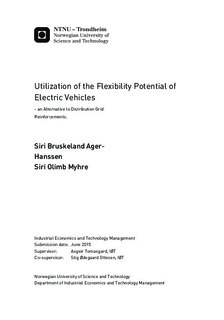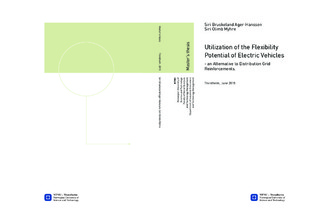| dc.description.abstract | Today, the transport sector accounts for a large share of global emissions. Electric vehicles have many environmental advantages compared to conventional petrol vehicles. Hence, if electric vehicles can replace petrol vehicles, the transportation sector's total emissions can be significantly reduced. In Norway, due to policy incentives, it is expected that the number of electric vehicles will increase considerably in the near future. Despite the great advantages of electric vehicles, large penetration of EVs poses many challenges for the electricity grid. When several EVs within the same distribution grid charge simultaneously, this may cause overloading of network components. The traditional way of solving capacity problems is to reinforce the grid to handle the highest peak load during a year. However, this is not optimal seen from a socio-economic perspective as the grid will be underutilized during a large part of the day and the year. With the grid of the future, smart grid, and Advanced Metering Infrastructure (AMI), alternatives to the traditional methods of handling grid congestion can emerge. With smart grid, real-time information concerning electricity consumption and grid conditions will be available, enabling the electricity consumer to supply, and the distribution system operators to utilize demand response. Demand response is flexibility of electricity consumption on the demand side. The EV is a type of load which is well suited for demand response, as the use is decoupled from the the electricity consumption. As long as the EV is ready for use when the owner needs it, it would be natural to be indifferent regarding how and when it is charged.
By utilizing the potential of smart grid, it can be avoided that the distribution grid becomes a limiting factor for the electrification of the transport sector. The purpose of this thesis is to provide the distribution system operators (DSOs) with guidance on how to prepare for the increasing penetration of EVs. The aim is to find good alternatives to grid reinforcements based on demand response, which can be adapted by a grid operator or a third party.
Principles and considerations regarding optimal design of grid tariffs suited for the new consumption pattern, have been presented and discussed. The main categories of proposed grid tariffs have been evaluated based on different criteria important to reveal the flexibility potential of consumers and ensuring socio-economic utilization of the grid. Two different price models for EV charging have been developed, which is a composition of some of the already proposed price models. As price signals do not guarantee the desired response from EV users, a direct control model for EV charging has been developed. The model can be used in combination with price signals to reduce the risk of congestion in the grid. Predictability of charging costs and complying to user preferences, was emphasized when creating the model. The model maximizes the total charging power for all EVs within a substation, while operating within the limitation of the grid and fulfilling the EV users preferences regarding desired battery level at the time of disconnection. In order to reveal the potential of the model, the model has been tested on a fictitious network with fictitious EV users.
By comparing the properties of the different allready proposed price models, a trade off was found between predictability for the EV user (how simple it is to plan load-shifting) and how accurately the tariff reflects the actual grid condition (if a congestion fee is charged only when there is congestion). A price model which tries to minimize this trade off has been created: a real-time purpose based tariff with fixed price lists. The aim of the model is to ensure predictability for the EV users regarding prices while still having the ability to utilize real-time information regarding grid condition. This is achieved by giving different price lists to different EV users, depending on when they connect to the charging point. As this is a demanding model to operate, and as it also can be perceived as unfair for the EV users, another model has also been created: a progressive purpose based day-ahead tariff. This model prices the charging power which exceeds what is referred to as normal charging, by a higher price per kWh, and the aim of the model is to find the prices for normal and fast charging, as these should vary with changing grid conditions. The results from the testing of the direct control model show that by utilizing direct control of EV charging, the distribution grid can tolerate a high penetration of EVs, which would have been very problematic if the charging was uncontrolled or controlled indirectly through price signals.
This paper demonstrates that with a high penetration of EVs there is a need for controlled charging to avoid large investments in increased capacity of the grid. Price signals can be used to control the charging of EVs indirectly, but also to ensure that an adequate amount of flexibility is offered when the charging is controlled directly. To ensure the success of demand response, the consumers must be taught to respond to price signals. Hence, the existence of educational signals is critical. Further, characteristics of the consumers and how they respond to prices must be recognized. Control models which are developed without understanding the consumers will never be a real alternative to grid reinforcements. | |

